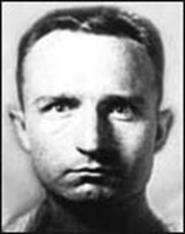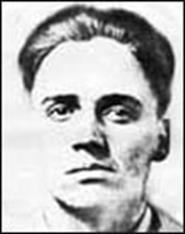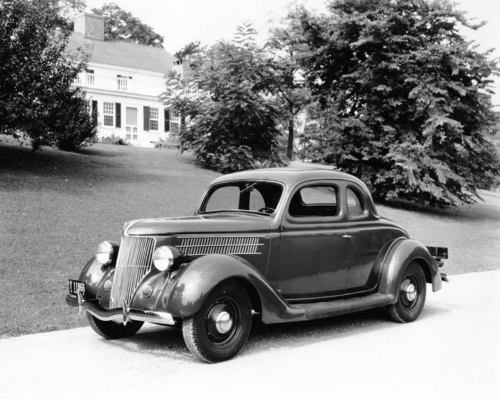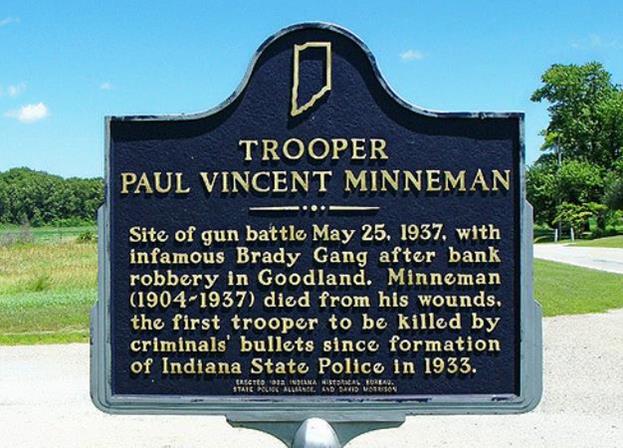
 Al
Brady Named 1937 “Public Enemy #1”
Al
Brady Named 1937 “Public Enemy #1”
as He and His Gang
Tried to “Out Dillinger,
Dillinger” in Their Stolen Ford V-8s
By John Emmering
The outlaws of the 1930’s seemed a thing of the past until
the Brady Gang staged a short lived crime revival. If the other gangsters were
bad, these were the worst, until they were eliminated with the aid of a true FBI
hero. Although they utilized several makes of automobiles, fate placed them in
a Ford V-8 during their most infamous crime.
Hunting for a new vehicle to operate in his gang’s robbery
spree, Alfred Brady’s eyes fixed on a new 1936 Ford V-8 coupe parked on a dark
residential street in Indianapolis, Indiana, on the evening of December 30,
1935. With the help of a few tools the Ford was entered and soon fired up and
cruising away in the night with Brady behind the wheel. The Ford V-8 would soon
be utilized in a frenzy of jewelry store and other robberies the gang was
perpetrating throughout western Ohio, central Indiana, and east central Illinois
as leader Alfred Brady, age 25, emulated the desperadoes of the lawless era of
1933-34. Brady tried to relive those anarchic days and was heard to brag that
he and his gang will “make Dillinger look like a piker”.
 Orphaned during his childhood in Indianapolis, Alfred Brady
became a drifter with no family connections. Brady met Rhuel James Dalhover,
his first recruit to the gang in Hanover Township, Indiana while he was working
on a farm. After Dalhover’s
bootlegging enterprise was destroyed by the Jefferson County Sheriff, Brady
lured Dalhover into accompanying him on robberies starting with a movie theater
and several rural stores. Before long habitual thief and delinquent Clarence
Lee Shaffer, Jr., age 19 joined the group along with the older Charles Geiseking.
Orphaned during his childhood in Indianapolis, Alfred Brady
became a drifter with no family connections. Brady met Rhuel James Dalhover,
his first recruit to the gang in Hanover Township, Indiana while he was working
on a farm. After Dalhover’s
bootlegging enterprise was destroyed by the Jefferson County Sheriff, Brady
lured Dalhover into accompanying him on robberies starting with a movie theater
and several rural stores. Before long habitual thief and delinquent Clarence
Lee Shaffer, Jr., age 19 joined the group along with the older Charles Geiseking.
Believing they could be more successful robbing jewelry
stores than banks, the gang planned a series of jewelry heists. On March 4,
1936, they robbed the Roy O. Wieland Jewelry Store in Greenville, Ohio, taking
at least $8,000 in jewelry. On March
19, 1936, the gang hit the Kay Jewelry Store in Lima, Ohio, departing with an
estimated haul of $6,900 in merchandise. Things turned deadly on March 21 when
the gang robbed Mohler’s Grocery in Piqua, Ohio. As clerk Edward Lindsay
unexpectedly emerged from the store’s cellar during the robbery, a panicked Al
Brady fatally shot the 23 year old.
Heading out of Ohio to avoid capture the gang traveled to
Chicago, a city they frequently visited. They came to the city to fence some of
their loot and to give Al Brady the chance to rendezvous with Margaret Larson, a
married woman with whom Brady had started an affair after they met earlier that
year in New Orleans, Louisiana. In Chicago Al Brady and his gang had problems
fencing their goods as Chicago mobsters took advantage of them and at one point
robbed them.
Things went downhill fast for the Brady Gang when they
repeated their robbery of the Kay Jewelry store in Lima, Ohio, on April 17,
1936. They encountered two policemen, one of whom who shot Geiseking in the leg,
but they evaded the police in a car chase.
Fleeing to Indiana, the gang members brought Geiseking to the home of an
Indianapolis physician for treatment.
The outlaws claimed he had been shot by a jealous husband and afterward
took Geiseking to stay with his family to recuperate. The gang returned to
speak to the doctor to ensure his silence but he had informed the police. As
Police Sergeant Richard Rivers approached the doctor’s home he was shot and
killed by either Dalhover or Shaffer.
The long arm of the law caught up with
Al Brady when he was arrested April 29, 1936, in a Chicago
hotel room he shared with Margaret Larson. Shaffer was later picked up by
Chicago Police on May 15. Dalhover
was soon arrested at his home in Indianapolis and Geiseking was apprehended in
Kentucky September 12, 1936. All were extradited to Marion County, Indiana, for
their Indianapolis area crimes. As a
result of a court granted change of venue, Brady, Dalhover, and Shaffer were
transferred to the Hancock County Jail in Greenfield, Indiana. The relocation
to the small understaffed Hancock County jail was unfortunate. On October 11,
1936, Brady, Dalhover, and Shaffer overpowered Sheriff Clarence Watson and
forced their way out of the jail. As the three fought Sheriff Watson outside of
the jail, local barber Edgar Ridlen exited his Chevrolet and helped fight off
the gang. The outlaws prevailed and
took off in Ridlen’s Chevy, having obtained a revolver from the Sheriff’s
office. The escape enraged FBI Director J. Edgar Hoover who designated Alfred
Brady Public Enemy #1 and with evidence of interstate criminal activity launched
a federal manhunt.
After the Greenfield jail break the gang drove east through
Ohio and on to West Virginia, pulling robberies along the way for travel funds.
The outlaws continued on to Baltimore, Maryland, where they paused and
rented rooms in a boarding house.
They settled in Baltimore and endeavored to live a peaceable life there,
occasionally returning to the midwest for their robberies, but staying clean in
Baltimore. This arrangement worked
for several months and the gang members took on assumed names.
Shaffer began dating a waitress named Minnie Raimondo and Dalhover took
up with her sister Mary. Soon Shaffer married Minnie and Dalhover, who already
had a wife in Indiana, married Mary.
The couples set up a household together in Baltimore.
Al Brady remained single however. Telling the sisters that they had to
travel for business the gang would return to the midwest for their crimes, now
consisting mainly of bank robberies.
 Driving back to Ohio May 12, 1937, the gang hunted for a new
car to replace the Chevrolet taken after their escape. They observed a 1937
Ford V-8 Tudor occupied by two women driving down a rural highway near
Bellefontaine and forced it off the road at gunpoint.
One gang member jumped from the Chevrolet and soon both vehicles
disappeared with the women left stranded on the side of the road. The Ford V-8
was used in the May 25, 1937, robbery of the Goodland Indiana State Bank.
An Indiana State Police car occupied by Trooper Paul Minneman and Deputy
Sheriff Elmer Craig began to track the Brady Gang’s Ford V-8 after the robbery.
The gang hid their Ford behind a church building and as the officers exited
their police car to look for the gang the Brady gang shot them. Trooper Paul
Minneman became the first Indiana State Policeman killed in the line of duty and
Deputy Craig received gunshot wounds.
Driving back to Ohio May 12, 1937, the gang hunted for a new
car to replace the Chevrolet taken after their escape. They observed a 1937
Ford V-8 Tudor occupied by two women driving down a rural highway near
Bellefontaine and forced it off the road at gunpoint.
One gang member jumped from the Chevrolet and soon both vehicles
disappeared with the women left stranded on the side of the road. The Ford V-8
was used in the May 25, 1937, robbery of the Goodland Indiana State Bank.
An Indiana State Police car occupied by Trooper Paul Minneman and Deputy
Sheriff Elmer Craig began to track the Brady Gang’s Ford V-8 after the robbery.
The gang hid their Ford behind a church building and as the officers exited
their police car to look for the gang the Brady gang shot them. Trooper Paul
Minneman became the first Indiana State Policeman killed in the line of duty and
Deputy Craig received gunshot wounds.
The gang quickly returned to their anonymity as family men
in Baltimore. When they were
observed by policemen moving guns from their legitimately acquired 1931 Buick to
the stolen Ford V-8 in August 1937, their cover in Baltimore was blown.
The Gang evaded capture but the police recovered the Buick which bore the
gang’s fingerprints and the Police and FBI learned of their adopted home.
Brady, Shaffer,and Dalhover quickly left Baltimore without any word to
Minnie and Mary Raimondo, who came under police intense police scrutiny. The
gang took off to Milwaukee, Wisconsin, where they robbed the People’s Exchange
Bank of $7,000.
 Returning to the east coast the Brady gang drove up to
Bangor, Maine, where they understood a very open policy existed on firearm
sales. The Gang purchased three .45
pistols at a gun shop and ordered two Thompson submachine guns, which then could
be purchased legally, for pickup on October 12, 1937. Having been tipped by the
sales clerk the FBI was waiting for the gang. As Dalhover entered the shop he
was arrested by expert marksman FBI special Agent Walter Walsh, who received a
gunshot wound. Shaffer and Brady died in a hail of bullets on Bangor’s main
street when they refused to surrender. Dalhover was executed one year later at
Michigan City, Indiana, for Trooper Minneman’ s murder. Thus the gang that tried
to imitate Dillinger in life also copied him and his gang in their untimely
demise.
Returning to the east coast the Brady gang drove up to
Bangor, Maine, where they understood a very open policy existed on firearm
sales. The Gang purchased three .45
pistols at a gun shop and ordered two Thompson submachine guns, which then could
be purchased legally, for pickup on October 12, 1937. Having been tipped by the
sales clerk the FBI was waiting for the gang. As Dalhover entered the shop he
was arrested by expert marksman FBI special Agent Walter Walsh, who received a
gunshot wound. Shaffer and Brady died in a hail of bullets on Bangor’s main
street when they refused to surrender. Dalhover was executed one year later at
Michigan City, Indiana, for Trooper Minneman’ s murder. Thus the gang that tried
to imitate Dillinger in life also copied him and his gang in their untimely
demise.